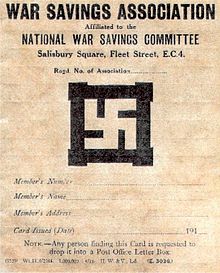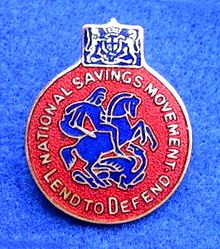



The National Savings Movement was a British mass savings movement that operated between 1916 and 1978 and was used to finance the deficit of government spending over tax revenues. The movement was instrumental during World War II in raising funds to support the war effort. In peacetime the movement provided an easy and safe way for ordinary people to save small sums of money. The movement grew to around 7 million members before ceasing during the 1970s as more modern methods of saving took over. Savings products promoted by the movement typically offered a low level of return but the safety of a government guarantee.
History
The movement was created in March 1916 as the National Savings Committee and this was supplemented by volunteer local committees and paid civil servants. A number of different organisations were loosely affiliated to make up the movement, including the Trustees Savings Banks and National Savings (previously the Post Office Savings Bank).
By 1946, the movement employed 1190 civil servants at an annual cost of £1.5 million, excluding unpaid volunteers. The amount raised by the movement at that time was £105,000 per week compared with £5 million in 1943.
According to a parliamentary answer, in 1950 there were about 185,000 local National Savings groups with a membership of about 7,000,000. The amount of small savings invested was over £6,100 million. The Trustee Savings Banks funds had reached £1,000 million.
On 30 March 1966, a ceremony was held at the London Guildhall to celebrate the 50th anniversary of the founding of the movement, which was attended by Queen Elizabeth II.
On 30 July 1976, the government announced that all 580 civil servants who supported the otherwise voluntary movement would be withdrawn over two years as part of public spending cuts. Without this administrative support the movement was unable to function, and its National Committee met for the last time on 16 February 1978. Attempts to restructure the movement into a more general money management service had failed because of a lack of financial support from the government and the banking industry.
Campaigns
The movement was particularly active during wartime, when government spending was heightened. During World War II a War Savings Campaign was set up by the War Office to support the war effort. Local savings weeks were held which were promoted with posters with titles such as "Lend to Defend the Right to be Free", "Save your way to Victory" and "War Savings are Warships".
Symbols
One of the early symbols of the movement was the swastika, but this was replaced with an image of St. George slaying the dragon before the start of the Second World War after the swastika was adopted by Nazi Germany.
Records
Archives of local savings committees may sometimes be found in local county archives, including in Wales, Essex, Walsall and others.
Ephemera
A wide range of printed and other ephemera exist for the movement including leaflets, membership certificates, posters in the popular styles of the period, savings stamps and enamel badges awarded to members for long service.
See also
References
- "National Savings Movement Records,". www.archiveswales.orveg.uk. Retrieved 24 March 2011.
- Hansard Debates 19 November 1946 vol 430 c685. Retrieved 24 March 2011.
- National Savings Movement Oral Answers to Questions: National Finance House of Commons debates, 21 November 1950. Retrieved 24 March 2011.
- Hansard Debates 22 February 1966 vol 725 cc221-2 Retrieved 24 March 2011.
- "What will follow National Savings?", Manchester Evening News, March 3, 1978, p.18
Notes
- See image above.
Further reading
- Burton, K.G. (1999) A penknife to a mountain: The early years of the National Savings Committee. National Savings.
External links
- The National Savings Movement at lightstraw.co.uk
- Life in the National Savings Department by BBC Radio Norfolk Action Desk
- War Savings Weeks by Stanley H Jones